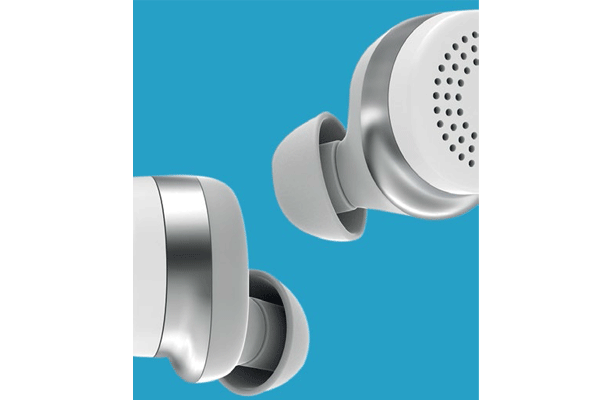Here One.


Here One.

The Here One wireless smart earbuds are the latest to join the fray, but where Doppler Labs say they differ from everything else is that they offer you the means to control not only the way you hear your music, but the way you hear the world.
An evolution of the Here Active Listening ear buds the company first launched on KickStarter, these allow you to stream music and make calls while giving you a Digital Signal Processor (DSP) that allows you to turn down the volume or amplify certain frequencies that you hear from the outside world.
In terms of looks, the Here One is sleek and modern-looking, with two color options; black and silver. The case is fairly well-designed too. It’s fairly slim, much like the case for the Bragi The Headphone, but has four indicator lights to indicate how much charge is remaining. The Hear One has a playtime of up to two hours, while the carrying case offers up an extra three extra charges when fully charged.
This brings the total possible playtime with the Here One up to eight hours, but it takes an hour to charge the headset once it’s been completely discharged. So, it’s supposedly a full day’s worth of listening with one-hour breaks in between.
One thing that stands out with these headphones is the amount of calibration they do at the start to create a unique profile for your ears.
A set of five test tones is played for each ear, while you adjust a slider to indicate at what volume you can hear each sound. This is then saved and used to adjust the way audio is played to your ears – and by this we don’t just mean your music, but sounds from the real world too.
That’s the greatest difference the headphones bring, but it seemed like there wasn’t really that much difference between presets, so we generally just left it at the maximum cancellation strength of -22. This let us focus on just the music, and we were really impressed by what we heard.
There’s good body to the audio, with nice depth and good clarity on the mids and highs. The midrange in particular seems to be a strength with these headphones. Vocals come out nice and clear, and both piano and guitar sounds are presented with great naturalness.
On a recording of Nils Lofgren’s Keith Don’t Go, you can pick up every squeak and squeal as he shifts from one chord to another and the high notes ring out sweet and true, so there’s plenty of detail to be had with these headphones.
Switch over to a recording of Don’t Know Why by Norah Jones, and the lower range of the Here One comes into play. The headphones do a great job of rendering the bass guitar in this piece with body and just the right amount of decay. Meanwhile, there’s good separation from the drum work and the vocals of the backup singers, so you can truly hear each of them.
This was again reflected on our formal test tracks, where we felt it performed best with Hotel California by The Eagles. The headphones did an excellent job of recreating the concert hall the band played in with its stereo imaging, making it feel like you’re right in the crowd.
At $459, the Here One is the most expensive pair of wireless earbuds we’ve tested thus far, but they’re also the most intelligent and the most musical we’ve heard too. The option to dial up the audio from your surrounds also works as advertised, though it can certainly get too loud if you’re not careful.
The biggest issue with these earbuds however, is the battery life.
We averaged only about an hour and a half of listening time per charge with these headphones. Given that it takes a full hour to get a full charge, it seems like you’ll be charging the buds almost as much as you’ll be listening to music with them, which is a real shame.























